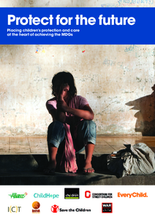The Millennium Development Goals (MDGs) have focused global efforts to improve the lives of the world’s poorest people. Yet many of the crucial targets are in danger of not being reached by 2015, which will have devastating impacts for the wellbeing of children throughout the world. This important report argues that a failure to provide proper care and protection for children is hindering progress in the achievement of many of the MDGs.
The Millennium Development Goals (MDGs) have done much to galvanise support for health, education and poverty alleviation in the developing world, and, ten years on from their inception, progress has been made against several of the MDG targets. However, in many parts of the world the poorest and most vulnerable are still unable to gain their basic rights to survival and education, and concerns have been raised that, without a change in approach, many MDG targets will not be met by 2015. The evidence presented in this report clearly shows that the widespread abuse of children’s rights to care and protection is in part responsible for hindering progress against the MDGs. These rights include a recognition of the central importance of family-based care for child wellbeing, and children’s right to be free from violence, exploitation, abuse and neglect.
The report is divided into five sections. Following on from the introduction, drawing on evidence relating to MDGs one to six, the second section shows how a recognition of children’s rights to care and protection is a vital component of efforts towards achieving the MDGs. The third section highlights the importance of including protection and care concerns in efforts to monitor the MDGs, and provides suggested equity indicators which encompass these concerns. The fourth section looks forward to the post-MDG framework, arguing that the absence of an explicit reference to child protection and care in the current MDGs needs to be addressed if such a framework is to be effective in improving children’s wellbeing in the future. Finally, the concluding section summarises the arguments made and provides policy recommendations to make the MDGs more effective.

